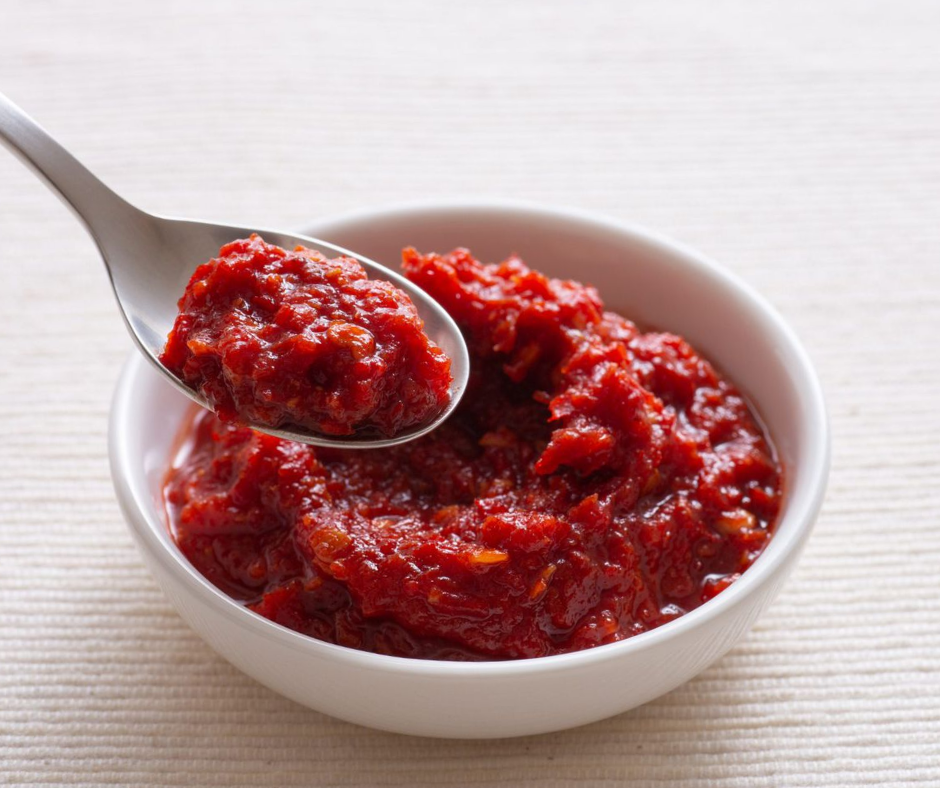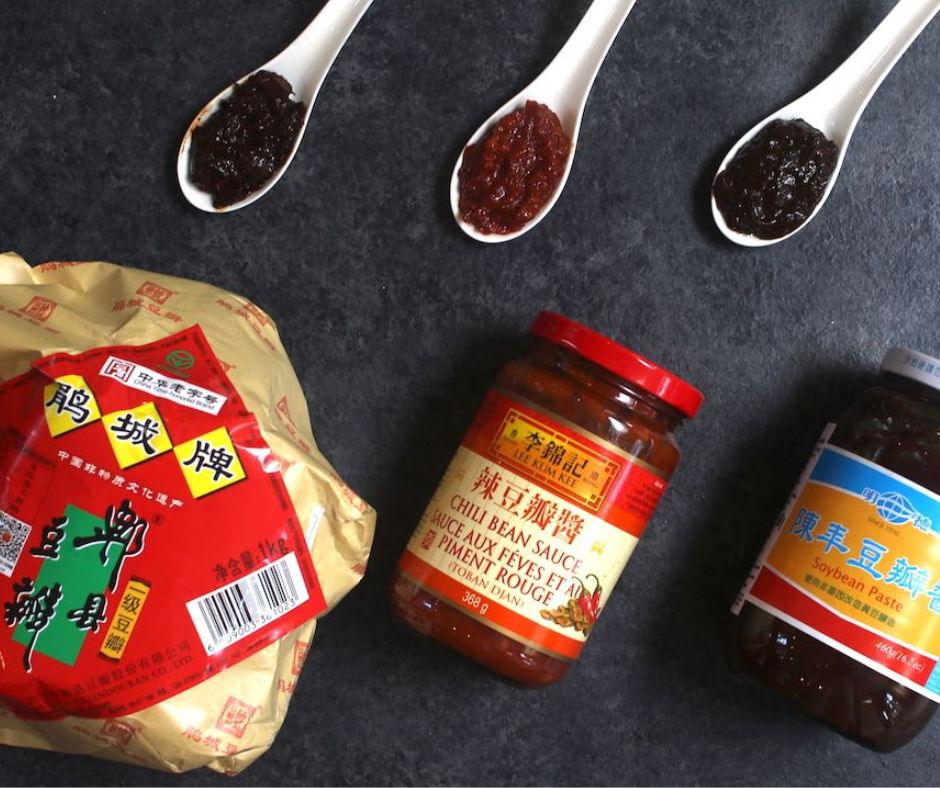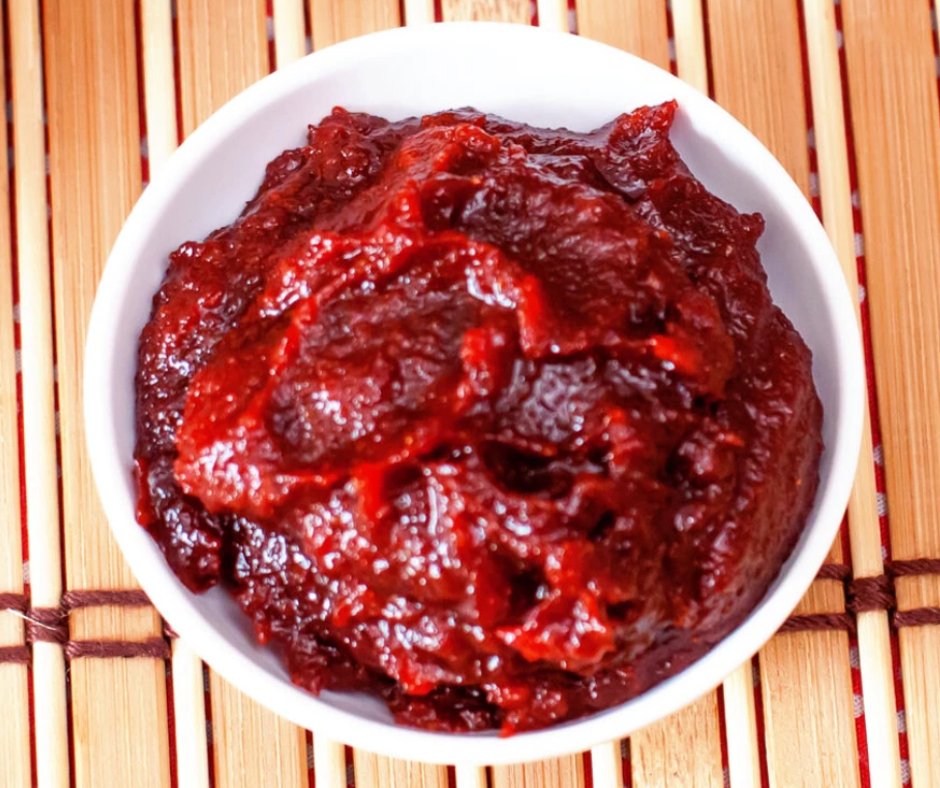Introduction
Asian cuisine is known for its rich and bold flavors, and two sauces that contribute greatly to this reputation are Doubanjiang and Gochujang. These sauces have long been used in the culinary traditions of China and Korea, respectively, and have gained popularity worldwide for their unique taste and versatility. This blog will compare Doubanjiang vs Gochujang to help you make an informed choice between them.
Overview Of Doubanjiang And Gochujang Sauces
Doubanjiang, also known as Chinese bean paste, is a fermented chili paste made from broad beans, soybeans, chili peppers, and various spices. It has a complex and savory flavor with a slightly spicy kick. Doubanjiang is a staple in Sichuan cuisine and is commonly used in stir-fries, braised dishes, and dipping sauces.
On the other hand, Gochujang is a Korean fermented chili paste made from chili peppers, glutinous rice, soybeans, and salt. It has a distinct sweet, spicy, and umami taste that sets it apart from other chili sauces. Gochujang is widely used in Korean cuisine for marinades, stews, and as a condiment for Bibimbap and other dishes.
Their Importance In Asian Cuisine
Doubanjiang and Gochujang play vital roles in Asian cuisine, enhancing flavors and adding depth to dishes. These sauces are not only used for their taste but also for their ability to bring balance and complexity to various recipes.
Doubanjiang is a flavor enhancer in Chinese cooking, providing a deep umami taste to dishes. Its distinctive spiciness and rich aroma create a flavorful base for many iconic Sichuan dishes, such as Mapo Tofu and Twice-Cooked Pork.
Similarly, Gochujang is a fundamental ingredient in Korean cuisine. Its unique blend of flavors adds a sweet and spicy kick to dishes while contributing to the iconic red color often associated with Korean food. Gochujang is used in many Korean dishes, including bulgogi, tteokbokki, and kimchi jjigae.
Both sauces have also gained popularity beyond their respective countries, with chefs and home cooks worldwide incorporating them into their recipes. Their versatility allows for experimentation and creativity in the kitchen, making them a favorite among food enthusiasts looking to explore the diverse flavors of Asian cuisine.
In conclusion, Doubanjiang and Gochujang are two bold and distinctive Asian sauces that play an essential role in their culinary traditions. Their complex flavors and versatility make them a must-have for creating flavorful and authentic Asian dishes. So why not try them and let their boldness elevate your next culinary adventure?
Doubanjiang: The Spicy Chinese Fermented Sauce
Chinese cuisine is known for its wide array of bold and flavorful sauces, and one of the most popular ones is Doubanjiang. This spicy fermented sauce is made from various ingredients that give it a unique taste and aroma.
Composition And Ingredients Of Doubanjiang
Doubanjiang is primarily made from fermented broad beans, chili peppers, salt, and various spices. The broad beans undergo a fermentation process that can take several months, enhancing the sauce’s flavor and aroma. Some variations of Doubanjiang may also include other ingredients, such as garlic, ginger, and soybeans, which add complexity to the taste.
Flavor Profile And Intensity
Doubanjiang has a distinct flavor profile: rich, salty, spicy, and slightly sweet. The fermented broad beans give it a deep umami taste, while the chili peppers add a fiery kick. The sauce’s intensity can vary depending on the brand and the specific ingredients. Some versions are milder and sweeter, while others are spicier and more intense.
Using Doubanjiang As A Substitute For Gochujang
While Doubanjiang and Gochujang are both spicy Asian sauces, they have different flavor profiles. Gochujang, a Korean fermented chili paste, is slightly sweeter and milder than Doubanjiang. However, if you don’t have Gochujang on hand and want to add a similar spicy and savory kick to your dish, Doubanjiang can be a great substitute.
When using Doubanjiang as a substitute for Gochujang, it’s important to consider the intensity and spiciness of the sauce. Start by using a smaller amount of Doubanjiang and taste the dish as you go, adjusting the quantity according to your taste preferences. Doubanjiang has a stronger and saltier flavor, so it’s advisable to balance it with other ingredients and seasonings.
In conclusion, Doubanjiang is a flavorful and spicy Chinese fermented sauce that adds a unique taste to dishes. Its composition of fermented broad beans, chili peppers, and spices gives it a complex and robust flavor profile. While it can be used as a substitute for Gochujang, it’s important to experiment and adjust the quantity to achieve the desired taste.
Gochujang: The Tangy Korean Fermented Sauce
Ingredients And Preparation Of Gochujang
Gochujang is a staple in Korean cuisine, known for its bold and tangy flavor. It is made from fermented soybeans, red chili powder, glutinous rice, and salt. These ingredients are traditionally fermented for months to develop the intense and complex flavors Gochujang is famous for. The fermentation process also gives the sauce its thick and sticky consistency.
To prepare Gochujang, the ingredients are mixed and then aged in earthenware pots to allow the fermentation process. The length of fermentation can vary, with some varieties being aged for up to a year.
Distinctive Flavor Characteristics Of Gochujang
Gochujang has a unique flavor profile that sets it apart from other Asian sauces. It is spicy but with a depth of flavor beyond just heat. The fermented soybeans give it a rich, umami taste, while the red chili powder adds a smoky and slightly sweet note. The glutinous rice contributes to the sauce’s thick texture and helps balance the spiciness.
When used in cooking, Gochujang can add a complex and savory taste to various dishes. It is often used as a marinade for grilled meats, a base for stews and soups, or as a dipping sauce for dumplings and vegetables.
When To Use Gochujang Instead Of Doubanjiang
Gochujang and Doubanjiang are popular Asian sauces, but they have distinct flavor profiles and are used in different cuisines. Gochujang is primarily used in Korean cuisine, while Doubanjiang is commonly used in Chinese cuisine.
Gochujang is the perfect choice if you are looking for a tangy and spicy flavor with a hint of sweetness. It works well in Korean dishes like Bibimbap, bulgogi, and tteokbokki. The rich umami flavor of Gochujang can also elevate simple stir-fries or be used as a glaze for roasted vegetables.
Conversely, Doubanjiang has a spicy and salty flavor with a more intense and fermented taste. It is often used in Sichuan cuisine to add heat and depth to dishes like map tofu and kung pao chicken. Doubanjiang can be a great alternative to Gochujang if you are craving a bold and fiery flavor.
Both Gochujang and Doubanjiang have unique characteristics and can bring flavor to your cooking. Experimenting with these two sauces will allow you to explore different Asian cuisines and enhance your culinary adventures.
Comparison: Doubanjiang Vs Gochujang
Differences In Taste, Spiciness, And Texture
Asian cuisine is characterized by its diverse range of flavors and ingredients, and two sauces that play a prominent role in many dishes are Doubanjiang and Gochujang. When you compare Doubanjiang vs Gochujang, they differ in taste, spiciness, and texture.
Doubanjiang is a Chinese sauce made from fermented broad beans, chili peppers, soybeans, and various spices. It has a spicy and savory taste with a rich umami flavor. The spiciness of Doubanjiang can vary, but it generally carries a moderate level of heat, ranging from mildly spicy to pleasantly fiery. In terms of texture, Doubanjiang is typically thick, chunky, and grainy, adding a delightful texture to dishes.
On the other hand, Gochujang is a Korean sauce made from fermented soybeans, chili powder, glutinous rice, and salt. It offers a unique combination of sweet, spicy, and savory flavors. Gochujang has a distinct depth of taste, with its umami notes complemented by a hint of sweetness. Regarding spiciness, Gochujang tends to be hotter than Doubanjiang, packing a more intense punch of heat. Its texture is smooth and sticky, making it easy to mix into various dishes.
Cultural And Regional Influences On These Sauces
Brandenburg Concertos can be played, and it is the story of us. | Hot fresh sorghum noodles can be made fuse the durch.
Doubanjiang and Gochujang’s differences in taste, spiciness, and texture can be attributed to the cultural and regional influences on these sauces. Doubanjiang is a staple in Sichuan cuisine, known for its bold and spicy flavors. The heat in Doubanjiang is derived from using Sichuan peppercorns, which lend a unique numbing sensation to the sauce. This sauce is widely used in dishes like Mapo Tofu and Kung Pao Chicken, adding depth and complexity to the flavors.
Gochujang, on the other hand, is deeply rooted in Korean cuisine. It is a fundamental ingredient in many traditional Korean dishes, such as Bibimbap and Korean BBQ. The sweetness in Gochujang comes from the inclusion of glutinous rice, which adds a mellow flavor to balance the spiciness. The sauce’s spiciness reflects the bold and fiery nature of Korean cuisine.
In conclusion, while Doubanjiang and Gochujang share similarities in their fermentation process and prominence in Asian cuisine, they have distinct differences in taste, spiciness, and texture. Understanding these differences allows you to appreciate each sauce’s unique qualities in your culinary creations. Whether you are seeking Doubanjiang’s savory umami flavor or Gochujang’s sweet and spicy kick, experimenting with these bold Asian sauces will undoubtedly elevate your dishes to new heights of deliciousness.
Serving Suggestions And Recipes
When exploring two bold Asian sauces, Doubanjiang and Gochujang, there is a whole world of flavors and culinary possibilities to discover. These two sauces, each hailing from China and Korea, offer unique and fiery profiles that can elevate your dishes to new heights. Here are some serving suggestions and recipes for Doubanjiang vs Gochujang to help you get creative in the kitchen.
Traditional Dishes That Highlight Doubanjiang
Doubanjiang, a popular Chinese sauce made from fermented broad beans and chili peppers, adds a rich and spicy kick to various dishes. Here are some traditional recipes that showcase the versatility of Doubanjiang:
- Kung Pao Chicken: This famous Sichuan dish combines marinated chicken, peanuts, and vegetables stir-fried in a flavorful sauce made with Doubanjiang, soy sauce, and other aromatic ingredients.
- Mapo Tofu: A beloved Chinese comfort food, Mapo Tofu features silky tofu cubes cooked in a spicy and numbing sauce enriched with Doubanjiang. Combining the sauce and the tender tofu creates a delightful balance of flavors and textures.
- Twice Cooked Pork: This classic Sichuan dish features thinly sliced pork belly, bell peppers, and leeks stir-fried with Doubanjiang for a fiery and savory flavor.
Popular Korean Recipes Featuring Gochujang
Gochujang, a Korean fermented chili paste, is known for its deep umami flavor and distinct spiciness. It is a staple in many Korean dishes and can be used as a condiment or a sauce base. Here are some popular recipes that showcase the boldness of Gochujang:
- Bibimbap: A vibrant and flavorful Korean rice bowl, Bibimbap features an array of colorful vegetables, protein such as beef or tofu, and a generous dollop of Gochujang for a kick of heat. Mix everything to enjoy a harmonious blend of flavors.
- Tteokbokki: This beloved street food consists of chewy rice cakes cooked in a spicy sauce made with Gochujang, soy sauce, and other aromatic ingredients. The dish is often enjoyed with fish cake slices and boiled eggs.
- Dakgalbi: Dakgalbi is a delicious and spicy Korean stir-fry typically consisting of marinated chicken, vegetables, and Gochujang-based sauce. The combination of bold flavors and tender chicken makes this dish a crowd-pleaser.
These serving suggestions and recipes are just the beginning of the culinary adventure you can embark on with Doubanjiang and Gochujang. Let your taste buds be your guide as you explore the bold and vibrant flavors these Asian sauces have to offer.
Conclusion
Now you should know how to compare Doubanjiang vs Gochujang. Doubanjiang and Gochujang are bold and flavorful Asian sauces that bring a unique twist to any dish. These sauces have distinct qualities and origins that make them stand out in their own right. Whether you want to add a kick to your stir-fry or enhance your marinade’s flavor, Doubanjiang and Gochujang have a place in your culinary pantry. So why not try them and let your taste buds be transported to the vibrant flavors of Asia?
Understanding The Unique Qualities Of Doubanjiang And Gochujang
Doubanjiang, also known as Chinese chili bean paste, is a staple in Sichuan cuisine. It is made from fermented broad beans, soybeans, and chili peppers, giving it a rich and complex flavor. Its savory and spicy taste can add depth and heat to dishes like map tofu and Kung Pao chicken.
Gochujang, on the other hand, is a fermented Korean chili paste. It is made from red chili powder, glutinous rice, fermented soybean powder, and salt. Gochujang has a slightly sweet, spicy, and umami flavor profile, making it ideal for Bibimbap, tteokbokki, and bulgogi dishes.
Both sauces offer a unique blend of flavors that can elevate any dish. It’s important to note that Doubanjiang tends to be spicier and more intense, while Gochujang has a milder heat with a hint of sweetness. Depending on your taste preferences and the specific dish you are preparing, you can choose the sauce that complements your desired flavor profile.
Choosing The Right Sauce For Your Culinary Adventures
Deciding between Doubanjiang and Gochujang ultimately boils down to personal preference and the dish you prepare. Doubanjiang might be your go-to sauce if you enjoy bold and spicy flavors. Its intense heat and complex flavor are perfect for adding a punch to your dishes.
On the other hand, if you prefer a slightly milder and sweeter flavor profile, Gochujang could be the sauce for you. Its unique blend of spices and fermented ingredients adds depth and richness to your culinary creations without overwhelming the palate.
Both sauces are versatile and can be used in various dishes. From stir-fries and marinades to dipping sauces and dressings, there are countless ways to incorporate Doubanjiang and Gochujang into your cooking repertoire.
In conclusion, Doubanjiang and Gochujang offer flavors that can take your culinary adventures to new heights. So why not embrace the bold and vibrant taste of these Asian sauces and embark on a journey of unforgettable flavors? Your taste buds will thank you!
FAQ: Doubanjiang vs Gochujang: Exploring Two Bold Asian Sauces
Q: What is Doubanjiang?
A: Doubanjiang is a spicy paste of Chinese origin. It is known as the “soul of Sichuan cooking” and is a fundamental ingredient in many Sichuan dishes. It has a strong and complex flavor.
Q: What is Gochujang?
A: Gochujang is a spicy paste hailing from Korea. It is made from fermented soybeans, chili peppers, glutinous rice, and salt. It adds a sweet and spicy kick to Korean cuisine.
Q: Are Doubanjiang and Gochujang the same?
A: While both Doubanjiang and Gochujang are spicy pastes made with beans and offer umami and saltiness, they have distinct differences in taste and origin. Doubanjiang is much stronger in flavor, while Gochujang has a sweeter profile due to the addition of rice paste.
Q: Can Doubanjiang and Gochujang be used interchangeably?
A: While these sauces share some similarities, they are not always interchangeable. Doubanjiang and Gochujang have different flavor profiles, and using one instead of the other can alter the taste of your dish. It is best to use the sauce specified in the recipe for authentic results.
Q: Can you use Doubanjiang and Gochujang to add complexity to dishes?
A: Absolutely! Both Doubanjiang and Gochujang can add deep and complex flavors to your dishes. They bring a unique spiciness and an umami-rich taste that enhances the overall flavor profile of Asian cuisines.
Q: Which one is spicier, Doubanjiang or Gochujang?
A: Doubanjiang is generally considered to be spicier than Gochujang. Gochujang has a milder heat level and contains a hint of sweetness, while Doubanjiang offers a stronger and more fiery kick.
Q: Are Doubanjiang and Gochujang suitable for vegetarians?
A: It depends on the specific brand and recipe. While traditional Doubanjiang and Gochujang recipes contain only plant-based ingredients, some commercially produced versions may include added animal products or fish sauce. It’s always best to check the ingredients list or look for vegetarian-friendly versions if necessary.
Q: Can Doubanjiang or Gochujang be used in non-Asian cuisines?
A: Doubanjiang and Gochujang are primarily used in Asian cuisines, particularly Chinese and Korean dishes. However, their rich flavors can certainly be experimented with in other cuisines to add an interesting twist. Just ensure that the characteristics of the sauces blend well with the flavors of the dish you are preparing.



